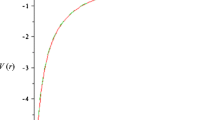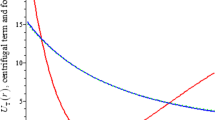Abstract
We study the quantum relativistic wave equations (Klein–Gordon and Dirac) for the non-pure dipole potential \(V(r)=-Ze/r+D\cos \theta /r^{2}\), in the case of two-dimensional systems. We consider either spin symmetry or anti-spin symmetry cases in our computations. We give the analytical expressions of the eigenfunctions, compute the exact values of the energies and study their dependence according to the dipole moment D. Our study generalizes the energies of the Kratzer potential as well as the magnetic quantum number m, which is replaced with the Mathieu characteristic values obtained during the resolution of the angular equations. For each magnetic quantum number, we demonstrate the existence of a critical value for the dipole moment, beyond which the corresponding bound state can no longer exist. We find that the critical value is null when \(m=0\); this means that these s-states cannot exist for this system and this is in agreement with non-relativistic studies.









Similar content being viewed by others
References
A.A. Makarov et al., A systematic search for nonrelativistic systems with dynamical symmetries. Nuovo Cimento A 52, 1061 (1967)
H. Hartmann, Die Bewegung eines Körpers in einem ringförmigen Potentialfeld. Theor. Chim. Acta 24, 201 (1972)
A. Hautot, Exact motion in noncentral electric fields. J. Math. Phys. 14, 1320 (1973)
A.D. Alhaidari, Solution of the Dirac equation by separation of variables in spherical coordinates for a class of three-parameter non-central electromagnetic potential. Ann. Phys. 320, 453 (2005). (Erratum-ibid. 321, 1524–1525 (2006))
S. Dong-Sheng et al., The quantum characteristics of a class of complicated double ring-shaped non-central potential. Phys. Scr. 89, 045002 (2014)
B.J. Falaye, S.M. Ikhdair, M. Hamzavi, Formula method for bound state problems. Few Body Syst. 56, 63–78 (2015)
G.F. Gribakin, A.R. Swann, Effect of dipole polarizability on positron binding by strongly polar molecules. J. Phys. B 48, 215101 (2015)
A. Bachkhaznadji, M. Lassaut, Solvable few-body quantum problems. Few Body Syst. 56, 1–17 (2015)
A. Özfidan, A. Durmus, Analysis of N-dimensional Klein–Gordon equation for hydrogen molecule in the non-central potential field. Ann. Phys. 396, 546–563 (2018)
L. Khodja, M. Achour, S. Zaim, Hartmann potential with a minimal length and generalized recurrence relations for matrix elements. Few Body Syst. 61, 17 (2020)
A.K. Geim, K.S. Novoselov, The rise of graphene. Nat. Mater. 6, 183 (2007)
A.H. Castro Neto, K.S. Novoselov, New directions in science and technology: two-dimensional crystals. Rep. Prog. Phys. 74, 082501 (2011)
H. Abdoul-Carime, J. Schermann, C. Desfrançois, Multipole-bound molecular negative ions. Few Body Syst. 31, 183–190 (2002)
H.-P. Liu, Y.-F. Duan, L. Yi, Anomalous optical and electronic properties of \(CaTiO_{3}\) perovskites. Commun. Theor. Phys. 48, 563 (2007)
K.M. Daily, Hyperspherical asymptotics of a system of four charged particles. Few Body Syst. 56, 809–822 (2015)
N.G. Aghekyan, E.M. Kazaryan, L.S. Petrosyan, H.A. Sarkisyan, Two electronic states in a quantum ring: Mathieu equation approach. J. Phys. Conf. Ser. 248, 012048 (2010)
N.G. Aghekyan, E.M. Kazaryan, H.A. Sarkisyan, Two electron states in a thin spherical nanolayer: reduction to the model of two electrons on a sphere. Few Body Syst. 53, 505–513 (2012)
Y. Gindikin, V.A. Sablikov, Spin-orbit-driven electron pairing in two dimensions. Phys. Rev. B 98, 115137 (2018)
A.D. AlHaidari, Analytic solution of the Schrödinger equation for an electron in the field of a molecule with an electric dipole moment. Ann. Phys. 323, 1709 (2008)
M.-C. Zhang, Tridiagonal treatment for the Schrödinger equation with a noncentral electric dipole ring-shaped potential. J. Math. Chem. 50, 2659–2670 (2012)
S.H. Patil, An electron in a finite-dipole potential. J. Chem. Phys. 120, 6399–6407 (2004)
M. Moumni, A. BenSlama, S. Zaim, A new limit for the non-commutative space–time parameter. J. Geom. Phys. 61, 51 (2011)
J. Simons, Theoretical study of negative molecular ions. Rev. Phys. Chem. 62, 107–128 (2011)
M. Moumni, M. Falek, Schrödinger equation for non-pure dipole potential in 2D systems. J. Math. Phys. 57, 072104 (2016)
K.T. Hecht, A. Adler, Generalized seniority for favored \(J\ne 0\) pairs in mixed configurations. Nucl. Phys. A 137, 129–143 (1969)
A. Arima, M. Harvey, K. Shimizu, Pseudo LS coupling and pseudo SU(3) couling shemes. Phys. Lett. B 30, 517–522 (1969)
J.N. Ginocchio, Pseudospin as a relativistic symmetry. Phys. Rev. Lett. 78, 436 (1997)
H. Liang, J. Meng, S.G. Zhou, Hidden pseudospin and spin symmetries and their origins in atomic nuclei. Phys. Rep. 570, 1–84 (2015)
Y.-F. Cheng, T.-Q. Dai, Solution of the Dirac equation for ring-shaped modified Kratzer potential. Commun. Theor. Phys. 48, 431 (2007)
O. Aydogdu, R. Sever, Exact pseudospin symmetric solution of the Dirac equation for pseudoharmonic potential in the presence of tensor potential. Few Body Syst. 47, 193–200 (2010)
Y.-J. Xiao, Z.-W. Long, Solution of Klein–Gordon equation for pseudo-Coulomb potential plus a new ring-shaped potential. Commun. Theor. Phys. 53, 54–56 (2010)
B.J. Falaye, Exact solutions of the Klein–Gordon equation for spherically asymmetrical singular oscillator. Few Body Syst. 53, 563–571 (2012)
M. Eshghi, H. Mehraban, S.M. Ikhdair, The relativistic bound states of a non-central potential. Pramana J. Phys. 88, 73 (2017)
W. Pauli Jr., Zur Quantenmechanik des magnetischen Elektrons. Z. Phys. 43, 601 (1927)
H. Snyder, J. Weinberg, Stationary states of scalar and vector fields. Phys. Rev. 57, 307 (1940)
C.-L. Ho, P. Roy, On zero energy states in graphene. EPL 108, 20004 (2014)
H. Hassanabadi, S. Zarrinkamar, A.A. Rajabi, Exact solutions of D-dimensional Schrödinger equation for an energy-dependent potential by NU method. Commun. Theor. Phys. 55, 541 (2011)
O. Langueur, M. Merad, B. Hamil, DKP equation with energy dependent potentials. Commun. Theor. Phys. 71, 1069 (2019)
J. Formánek, R.J. Lombard, J. Mareš, Waveequations with energy-dependent potentials. Czech. J. Phys. 54, 289–315 (2004)
J. García-Martínez, J. García-Ravelo, J.J. Peña, A. Schulze-Halberg, Exactly solvable energy-dependent potentials. Phys. Lett. A 373, 3619–3623 (2009)
R. Yekken, R.J. Lombard, Energy-dependent potentials and the problem of the equivalent local potential. J. Phys. A Math. Theor. 43, 125301 (2010)
R. Yekken, M. Lassaut, R.J. Lombard, Bound states of energy dependent singular potentials. Few Body Syst. 54, 2113–2124 (2013)
A. Schulze-Halberg, Ö. Yeşiltaş, Generalized Schrödinger equations with energy-dependent potentials: formalism and applications. J. Math. Phys. 59, 113503 (2018)
P. Alberto, A.S. de Castro, M. Malheiro, Spin and pseudospin symmetries and the equivalent spectra of relativistic spin\(-1/2\) and spin\(-0\) particles. Phys. Rev. C 75, 047303 (2007)
E. Mathieu, Mémoire sur le mouvement vibratoire d’une membrane de forme elliptique. J. Math. Pures. Appl. 13, 137 (1868)
M. Abramowitz, I.A. Stegun, Handbook of Mathematical Functions (Dover Publications, New York, 1972)
G. Floquet, Sur les équations différentielles linéaires à coefficients périodiques. Annales de l’Ecole Normale Supérieure 12, 47 (1883)
F. Bloch, Über die Quantenmechanik der Elektronen in Kristallgittern. Z. Phys. 52, 555 (1928)
J. Meixner, F.W. Schäfke, G. Wolf, Mathieu Functions and Spheroidal Functions and Their Mathematical Foundations: Further Studies. Lecture Notes in Mathematics, vol. 837 (Springer, Berlin, 1980)
I.S. Gradshteyn, I.M. Ryzhik, in Table of Integrals, Series, and Products, ed. by A. Jeffrey, D. Zwillinger (Elsevier, London, 2007)
B. Zaslow, M.E. Zandler, Two-dimensional analog to the hydrogen atom. Am. J. Phys. 35, 1118 (1967)
D.G.W. Parfitt, M.E. Portnoi, The two-dimensional hydrogen atom revisited. J. Math. Phys. 43, 4681 (2002)
C. Berkdemir, Relativistic treatment of a spin-zero particle subject to a Kratzer-type potential. Am. J. Phys. 75, 81 (2007)
A. Arda, R. Sever, Exact spin and pseudo-spin symmetric solutions of the Dirac–Kratzer problem with a tensor potential via Laplace transform approach. Mod. Phys. Lett. A 27, 1250171 (2012)
R.L. Hall, N. Saad, Smooth transformations of Kratzer’s potential in N dimensions. J. Chem. Phys. 109, 2983 (1998)
S.M. Ikhdair, R. Sever, Exact quantization rule to the Kratzer-type potentials an application to the diatomic molecules. J. Math. Chem. 45, 1137 (2009)
B.C. Lütfüoglu, Scattering of Klein–Gordon particles in the background of mixed scalar–vector generalized symmetric Woods–Saxon potential. Eur. Phys. J. Plus 133, 309 (2018)
B.C. Lütfüoglu, On the role of differentiation parameter in a bound state solution of the Klein–Gordon equation. Commun. Theor. Phys. 71, 267 (2019)
F.M. Fernández, Bound states of a charged particle in the field of an electric quadrupole in two dimensions. J. Math. Chem. 52, 1576 (2014)
E. Fermi, E. Teller, The capture of negative mesotrons in matter. Phys. Rev. 72, 399 (1947)
Acknowledgements
This work was done with funding from the DGRSDT of the Ministry of Higher Education and Scientific Research in Algeria as part of the PRFU B00L02UN070120190003. The authors would like to thank the reviewer who greatly contributed to improving the quality of this work with his remarks and comments.
Author information
Authors and Affiliations
Corresponding author
Additional information
Publisher's Note
Springer Nature remains neutral with regard to jurisdictional claims in published maps and institutional affiliations.
Rights and permissions
About this article
Cite this article
Moumni, M., Falek, M. & Heddar, M. Solutions of Klein–Gordon and Dirac Equations for Non-pure Dipole Potential in 2D Systems. Few-Body Syst 61, 47 (2020). https://doi.org/10.1007/s00601-020-01580-2
Received:
Accepted:
Published:
DOI: https://doi.org/10.1007/s00601-020-01580-2




